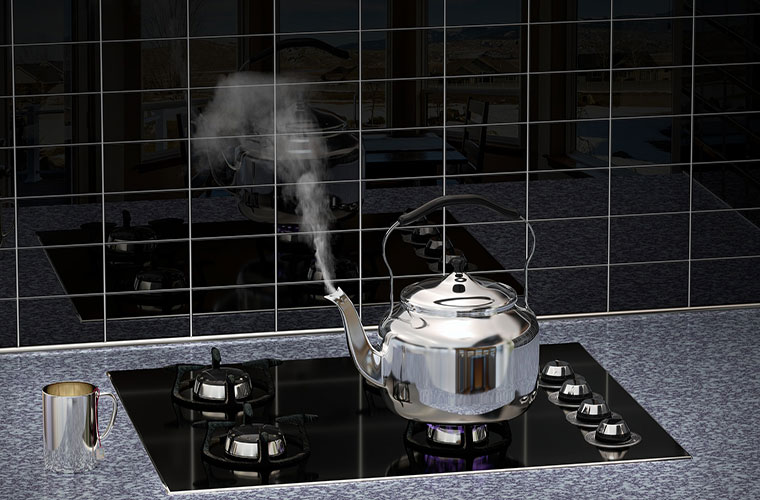If you have noticed unsightly and irritating marks on your household surfaces, or are bothered by floating deposits in your kettle, it is likely that you have problems with limescale.
Limescale is a natural deposit that occurs in hard water areas such as East Anglia. Hard water contains a high proportion of magnesium and calcium. Calcium carbonate, although invisible when dissolved, leaves scum marks and flakes when it has been heated. These deposits are what we know as limescale.
The stains and mineral deposits caused by hard water can be cleaned using the right methods but, if you don’t enjoy cleaning and long for bright, shining surfaces, it is possible to get rid of problem limescale altogether by fitting a water softener.
We take a look at how to remove limescale from different household surfaces and appliances.
Is limescale bad for you?
Although limescale can cause damage to appliances and be a nuisance, it does not present a health risk to people. However keeping well hydrated is important to health and, if the presence of limescale in your kettle or water is putting you off drinking, maybe it is time to consider a water softener.
How to remove limescale from a kettle
It is possible to buy kettle-cleaning kits to deal with problem limescale deposits in your kettle but natural cleaning methods can be just as effective.
- Fill your kettle with water and white vinegar (or lemon juice) in equal amounts
- Leave this mix to soak for an hour
- Boil the kettle
- Tip the mixture away and give the kettle a good rinse
- Wipe down the outside of the kettle with your vinegar and water mix
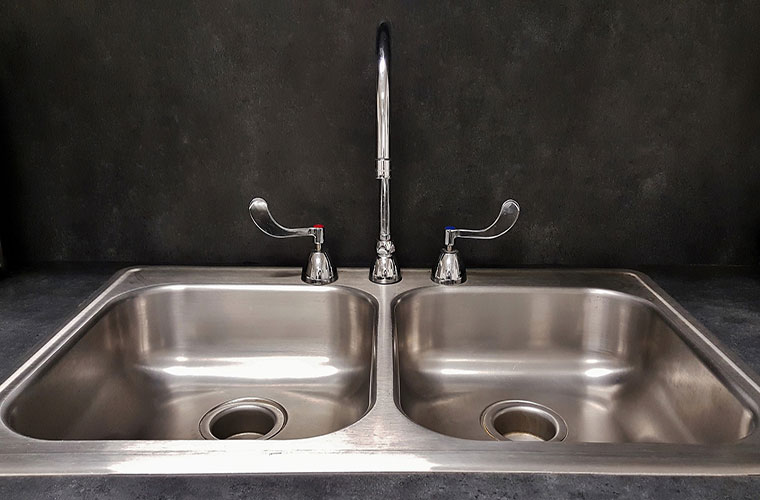
How to clean a sink and remove hard water stains
Whilst a stainless steel sink will show more hard water stains than a porcelain one, these irritating deposits will make the surface on both feel rough. Porcelain sinks in particular are susceptible to marking with abrasive cleaners so a gentle method of removing limescale is recommended.
To remove limescale from a porcelain sink
- Use warm water, washing up liquid and a soft sponge to remove any surface dirt or grease
- Combine white vinegar (one part) with bicarbonate of soda (two parts) and blend this into a paste
- Use your fingers to rub this white paste into any hard water stains.
- Wait while the paste softens the limescale patches (five minutes)
- Gently scrub each stain with your soft sponge
- Rinse the sink to remove any remaining paste
- Dry the sink and polish the taps
To remove limescale from a stainless steel sink
- Mix up a solution of water (five parts) and white vinegar (one part)
- Using a soft cloth or sponge carefully clean away each hard water stain
- Rinse the sink to remove any remaining solution
- Dry the sink and polish the taps
Commercial descaling products are also available and can be a useful and effective alternative for stubborn hard water stains.
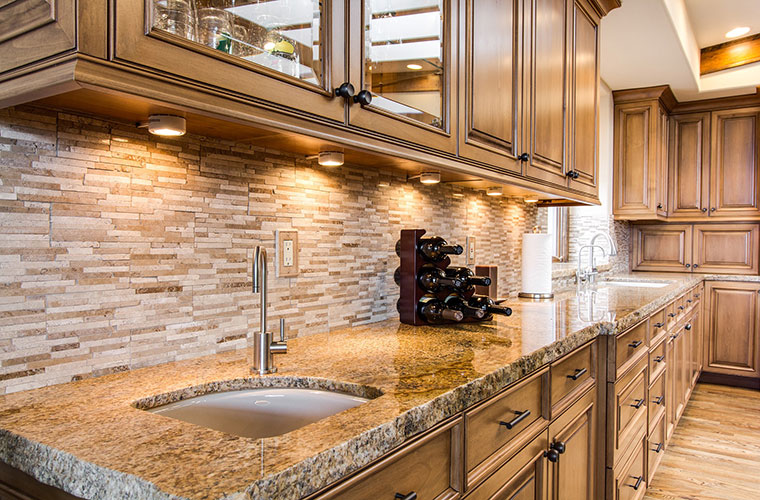
How to clean hard water stains off granite
Granite is well known as a hard-wearing and beautiful material for the kitchen. Unfortunately if you live in a hard water area, darker granite can be prone to limescale deposits. Cleaning hard water stains from granite sinks and countertops can be tricky because the natural stone is often protected by a sealant that has been placed to avoid scratching.
- Clean your granite sink with a non-abrasive scrubbing pad, warm water and washing-up liquid
- Dry your sink off and check for limescale deposits
- If hard water stains are still apparent, clean your granite sink again with a paste made from water (1 part) and bicarbonate of soda (three parts)
- For stubborn stains leave this paste in position for a few hours before rinsing
How to remove limescale from a toilet
No matter how well or often you scrub, limescale deposits in a toilet can be difficult to remove and look very unsightly. The area of the toilet bowel that sits below the water can be particularly vulnerable to hard water stains and is often tricky to clean. With some patience, it is possible to remove limescale from a toilet but this job is best done just before you go out, as you won’t be able to use the toilet for a few hours.
- Put on a pair of protective gloves
- Empty the toilet bowl of water. You can do this by scooping it out or pushing it around the bend with a toilet brush
- Pour enough undiluted white vinegar into the bowl to cover the limescale deposits
- Leave for as long as you can (preferably a few hours)
- Scrub the bowl with the toilet brush then flush
How to deal with hard water stains on laminate countertops
Laminate countertops are usually fairly stain resistant but they can attract unsightly hard water stains, which will show up even more if you have chosen a dark theme for your kitchen. It is important to avoid using chemical cleaners or harsh cloths on a laminate countertop, so we recommend a more gentle natural approach.
- Use warm water, washing up liquid and a soft sponge to remove any dirt or grease from your laminate surface
- Make a paste of water (1 part) and bicarbonate of soda (three parts)
- Cover each stain with the paste
- Wait for 30 minutes
- Wipe the laminate countertop clean and dry it thoroughly
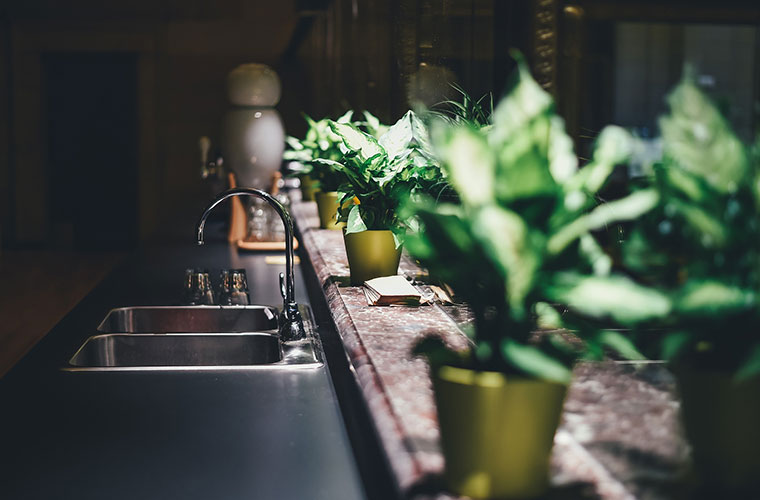
How to remove limescale from taps
Whilst only a water softening system can protect the inside of your taps from hard water, it is possible to remove limescale from the outside, leaving them clean and shining. Taps are fiddly to clean so a paste sometimes works better than a liquid solution.
To remove limescale from stainless steel taps
- Mix a thick paste of bicarbonate of soda (two parts) and white vinegar (one part)
- Spread this paste over any limescale deposits
- Leave in place for 30 minutes
- Rinse and dry
To remove limescale from copper or brass taps
- Mix together a paste of bicarbonate of soda (two parts) and white vinegar (one part)
- Rub this paste into any hard water stains
- Leave the paste in place for 30 minutes
- Rinse and dry
To remove limescale from chrome taps
- Chrome can be delicate so use a gentle touch
- Apply some lemon juice to a damp cloth and rub the stained area
- If this doesn’t work use a bicarbonate of soda paste but only leave it on the surface for a short time
Whichever type of tap you have, you might find an old toothbrush useful to help you get into those small spaces.
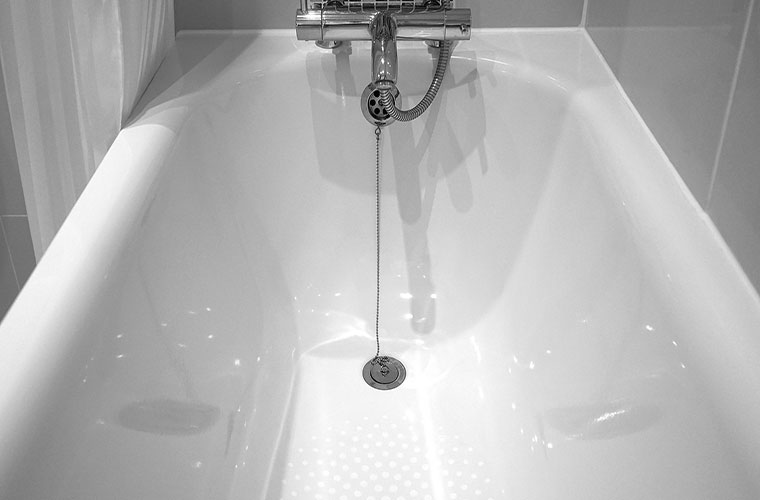
How to clean hard water stains off a bathtub
For many of us the bathtub is a place that we rest but it can be difficult to relax in a bath that looks dirty because of hard water stains. The good news is that it is possible to remove limescale from a bath.
- Make a thick paste with equal parts of white vinegar and bicarbonate of soda
- Apply this paste to any hard water stains
- Leave the paste for around 15 minutes
- Rinse and repeat as necessary
- For really stubborn limescale marks leave the paste on overnight
How to remove limescale from glass
If you like a pristine bathroom, there can be nothing more annoying than hard water stains on areas of glass. For example with plenty of water and little time to dry between uses, removing limescale from a shower door can be a time-consuming task.
How to remove limescale from a shower door
Mix up a solution of equal parts water and white vinegar
Put the solution into a pump action bottle and squirt onto the shower door
Leave the solution on the door for ten minutes then wipe off
Rinse the door and repeat for any stubborn stains
How to remove hard water stains from drinking glasses
Cloudy drinking glasses can make even the most attractive of drinks look unappealing. Glasses can sometimes become less clear if they are washed frequently in the dishwasher but in hard water areas, this fuzziness is often due to limescale deposits. It is best to clean all glasses gently in warm soapy water but if hard water stains are a problem follow the cleaning tips below.
- Pour some white vinegar into a container but don’t fill it
- Soak your glasses in the vinegar for 15 minutes
- Remove the glasses and clean them in warm soapy water
- Dry the glasses carefully
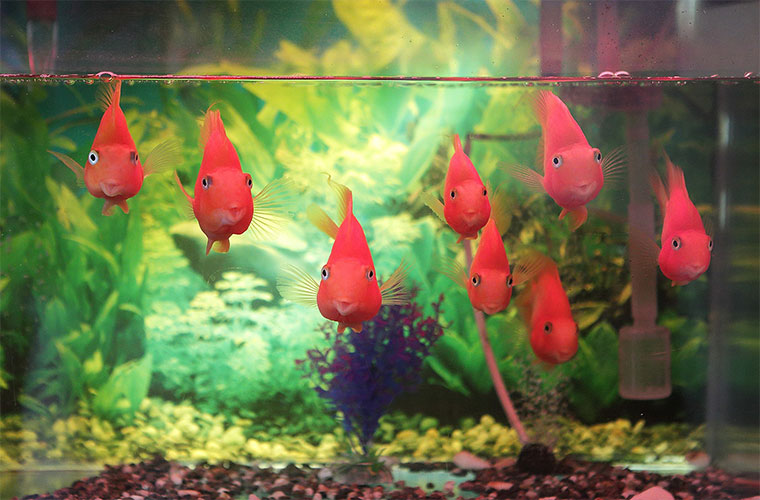
How to get rid of hard water stains on an aquarium
No matter how beautiful your fish are an aquarium with hard water stains won’t look attractive. If you want to protect your fish you must resist the temptation to clean your tank with cleaning products, as these can be lethal to fish. A far safer option is to use white vinegar.
- Remove your fish from the tank and put them somewhere safe
- Empty the tank and drain it
- To avoid damage to surrounding areas, place the tank on a towel
- Cover any areas of limescale deposit with white vinegar
- Leave the vinegar in place for 10-20 minutes
- Scrub the area gently with a soft cloth
- If you have a glass tank, you can use a razor blade to scrape off any stubborn hard water deposits
How to prevent hard water stains and limescale deposits
When it comes to limescale removal, taking preventative measures can save you a lot of time. If you live in a hard water area, you can’t stop these minerals coming into your home but there are some effective things you can do to stop hard water stains from forming in the first place.
- Use a limescale prevention product on areas that are often wet
- On showers door get into the habit of using a wiper blade and dry cloth to remove water before it can deposit limescale
- Dry sinks and taps after you have used them
- Prevent the build up of stains by making limescale removal part of your regular cleaning regime
- Invest in a professionally fitted water softener
Hart Water provide independent water softener services all over East Anglia. With a wealth of experience and knowledge, we offer a wide range of products as well as a complete installation and maintenance program. Get in touch with our team today to find out how we can help you turn your back on limescale removal problems and enjoy the benefits of soft water and shining surfaces around your home.
- Salt Free Water Softeners vs. Salt Water Softeners - February 2, 2024
- Fix Common Quooker Tap Problems quickly - November 15, 2023
- DIY vs. Professional Water Softener Servicing: Pros and Cons - October 3, 2023

